To reclaim ancestral land, all Native Hawaiians need is a $300,000 mortgage and to wait in line for decades
ProPublica is a nonprofit newsroom that investigates abuses of power. Sign up to receive ProPublica’s biggest stories Opens in a new tab as soon as they’re published.
This story was co-published with the Honolulu Star-Advertiser, a member of the ProPublica Local Reporting Network Opens in a new tab. Sign up to receive Star-Advertiser’s free e-newsletters to stay in touch with what’s happening in Hawaii.
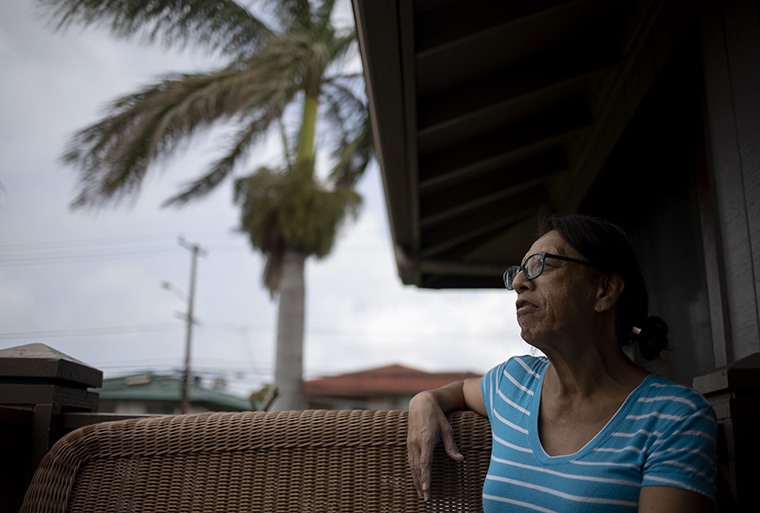 CINDY ELLEN RUSSELL / CRUSSELL@STARADVERTISER.COM
CINDY ELLEN RUSSELL / CRUSSELL@STARADVERTISER.COMZalei Kamaile, who lives in a public housing project, is about 3,500 applicants deep on the homestead waitlist.
A 100-year-old program created to provide Native Hawaiians — especially poor ones — land to live on after the U.S. annexed the islands is failing. Thousands have died waiting in line and even more can’t afford the mortgages they’d need.
Zalei Kamaile dreamed of owning a home.
The professional ukulele player worked long hours entertaining tourists on Oahu and saved her tips in a cookie jar. The money went into a modest house fund for her and her mother, but she knew that wouldn’t be enough. So in 1987, Kamaile, then 35, took the one step she considered her best shot at homeownership. She applied to a homesteading program for Native Hawaiians. Created by Congress in 1921, the program had a singular goal: return Hawaiians — especially impoverished ones — to their native lands.
Don't miss out on what's happening!
Stay in touch with breaking news, as it happens, conveniently in your email inbox. It's FREE!
Over the next two decades, Kamaile received more than a dozen letters offering her an opportunity to get a homestead. The land, part of a 203,000-acre trust, would be virtually free under a long-term lease. But there was a catch: An applicant either had to build their own home or purchase one from a developer. At least five of Kamaile’s offers were for new subdivisions in Kapolei, a growing bedroom community in West Oahu. Amid a soaring real estate market, the homes were a bargain, costing about half the price of similar housing elsewhere.
Kamaile, however, couldn’t qualify for a mortgage.
During that period, she lost her job, declared bankruptcy and spent two years homeless, part of it living in a tent on the beach. Kamaile passed on each offering, tossing the letters in the garbage. “I cried an awful lot,” she said.
Today, Kamaile, 68, still doesn’t have a homestead. She’s about 3,500 applicants deep on a waitlist, 33 years after she first applied. She lives in a cramped rental apartment in a low-income housing project and serves as caregiver for a disabled family friend who lives with her. Kamaile’s mother died last year, 10 days shy of her 91st birthday. Kamaile still regrets not being able to provide her with a homestead. “That was my one wish for her.”
The Honolulu woman’s story reflects what has been a decadeslong failure of the state Department of Hawaiian Home Lands to fulfill its mission.
Under state law, anyone who is at least half Hawaiian and 18 or older is considered a beneficiary of the land trust and entitled to get a homestead in a “prompt and efficient manner.” Qualifying for financing is not listed as a requirement, but that has essentially become one because of the way the program is run. As a result, Hawaiians with the financial means and knowledge to navigate the complicated system are able to get homesteads with relative ease while thousands of others continue a generations-long wait for the land that is their birthright, an investigation by the Honolulu Star-Advertiser and ProPublica has found.
Over the past 25 years, the department, known as DHHL, has largely invested in building sprawling subdivisions. Intended to satisfy a crushing demand for housing, the remedy has exacerbated the problem, as the homes have proved too expensive for many applicants.
The result has been an ever-lengthening waitlist, now 23,000 people long, as Native Hawaiians struggle in one of the country’s most expensive housing markets. At the average rate the department has developed residential lots since 1995, it would take 182 years to meet demand — before figuring in expected waitlist growth.
State and federal watchdogs have long criticized the department for its failure to deliver homesteads in a timely fashion, and this year, the Hawaii Supreme Court concluded that “the state of Hawaii has done little to address the ever-lengthening waitlist” over the past 30 years.
Under the current model, the department often goes thousands deep to find interested and qualified buyers, effectively bypassing low-income Hawaiians who have been waiting longer.
Since 1995, for example, DHHL has awarded about 2,200 residential leases to Oahu residents. Sixty percent of them went to beneficiaries who came from census tracts with median household incomes higher than $75,000, the two news organizations found through an unprecedented analysis of tens of thousands of lease transactions, waitlist records and other documents.
Jade Miyazaki was one of them. A hotel marketer, she already owned a small townhouse, but she applied for the homesteading program hoping to get more space for her family of five.
She got a home in 2010 in Kanehili, one of the subdivisions that Kamaile, the ukulele player, passed on. Miyazaki had waited only a quarter of the time even though she was more than 2,000 places deeper on the waitlist. But unlike Kamaile, Miyazaki could afford the mortgage.
She was among the last of the so-called waitlisters to be awarded land leases in the 375-home subdivision, where home prices at the time averaged about $345,000 in today’s dollars.
Today, the median household income for Kanehili and two other nearby homestead subdivisions is about $100,000. That is nearly double the approximately $55,000 median income for waitlister households, according to a 2017 federal study on Native Hawaiian housing.
“This program creates a division among Hawaiians,” said Vanessa Garcia Phillips, a beneficiary leader who has been on the waitlist a relatively short three years. “You have the haves and the have-nots.”
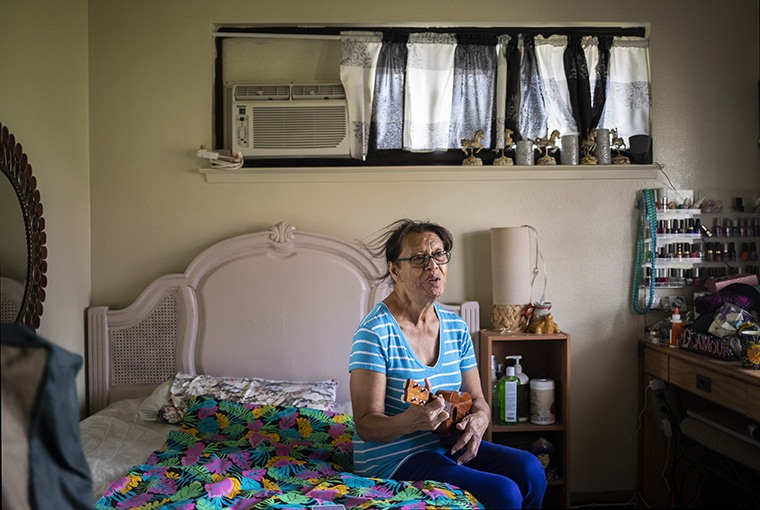 CINDY ELLEN RUSSELL / CRUSSELL@STARADVERTISER.COM
CINDY ELLEN RUSSELL / CRUSSELL@STARADVERTISER.COM Kamaile had been on the homestead waitlist for 23 years when she passed on a home in Kapolei.
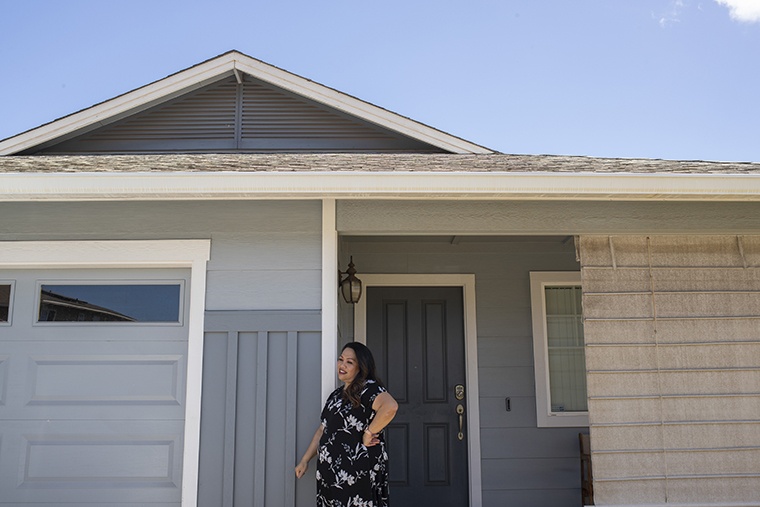 CINDY ELLEN RUSSELL / CRUSSELL@STARADVERTISER.COM
CINDY ELLEN RUSSELL / CRUSSELL@STARADVERTISER.COM Jade Miyazaki, who was able to afford the mortgage on a Kapolei homestead, had waited only a quarter of the time.
In the meantime, more Hawaiians will continue to die waiting. Analyzing trust records, the Star-Advertiser and ProPublica found that more than 2,000 beneficiaries already have died while on the waitlist without receiving homesteads — a number that has not been previously reported but that many agree is a severe undercount. The department records the death of a beneficiary only if the family provides a death certificate.
The investigation by the news organizations marks the first time DHHL’s subdivision strategy has been extensively examined, and many of the findings are new — even to DHHL. The agency said it didn’t have the staff or tools to replicate the analysis, but it acknowledged its model produced housing prices beyond the reach of many waitlisters.
>> RELATED: How we found low-income Hawaiians were left behind by the homesteading program
Still, officials defended the approach, saying they were doing what they could to deliver on what waitlisters consistently rank in surveys as their top choice: single-family homes. When the department built duplexes about two decades ago, it got a lackluster response from beneficiaries, some of whom believe the law promises them land, not just housing.
About 8,400 residential leases have been awarded since 1921, said William J. Aila Jr., who serves as department director and chairman of the Hawaiian Homes Commission, which oversees the agency and the land trust. To address the affordability problem, he said, the department has provided a greater number of less-costly lease options, such as empty lots where beneficiaries can build their own homes. It also offers services like financial literacy classes to help low-income beneficiaries.
“It’s not a complete success. But it’s not a complete failure,” said Aila, who lives on a homestead.
Many beneficiary advocates and political leaders disagree. They say the agency needs to overhaul its approach and to focus more on housing that waitlisters actually can afford.
“It’s not working for anybody,” said former Gov. John Waihee, the only Native Hawaiian to serve in that office — his term ran from 1986 to 1994 — and whose father died while on the waitlist. “It’s not working for the community. It’s not working for the state of Hawaii. If the program were doing what it should, we would have less of a housing crisis than we have now.”
A PRINCE’S VISION
In 1893, the U.S. backed an illegal overthrow of the Hawaiian monarchy, partly to protect U.S. sugar interests in the islands. A group representing U.S. and European sugar planters, financiers and missionary descendants, supported by U.S. naval forces, deposed the monarchy and proclaimed a provisional government. Five years later, the U.S. annexed the island chain, obtaining roughly 1.8 million acres of former kingdom land without compensating the Hawaiians. By then, the indigenous population was headed toward extinction as disease, poor living conditions and other factors contributed to their dwindling numbers. Many impoverished Hawaiians, who had been displaced from their lands, lived in slum-like tenements in urban Honolulu.
Prince Jonah Kuhio Kalaniana’ole, considered the father of the Hawaiian Homes program and Hawaii’s then-nonvoting delegate to Congress, around 1918 envisioned using some of the former kingdom lands to create a land trust to uplift Native Hawaiians. Kuhio’s idea was to return them to their native lands so they could become self-sufficient, maintain the culture and reverse the population decline. “This rehabilitation bill is the first opportunity given the poor man to go on the land with funds to help him make a living,” Kuhio said in Honolulu in 1920 as he lobbied to build public support.
The Hawaiian Homes Commission Act was signed into law in 1921. But the program, run by Hawaii’s territorial government under U.S. supervision, was seriously hampered from the start.
Much of the land was remote and ill suited for homesteading, lacking water and other basics. And the federal government provided little funding and inadequate oversight. In the first 38 years, only about 1,700 homesteads were awarded. The poor conditions persisted after the state took over management as a requirement of statehood in 1959.
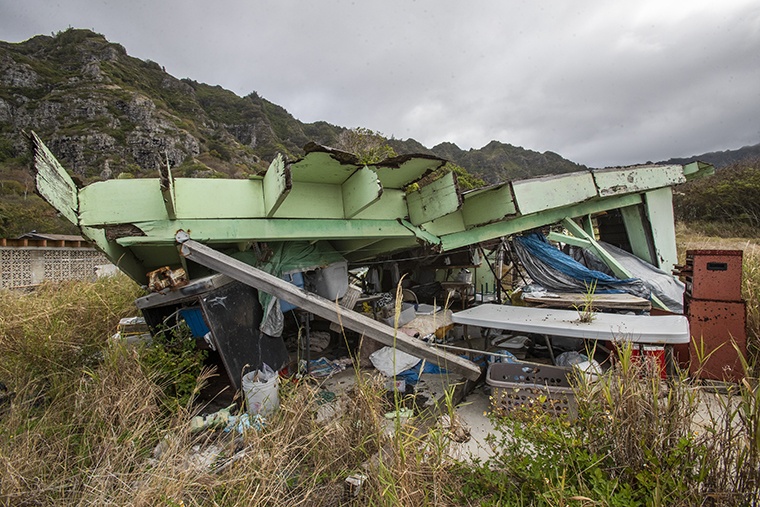 CINDY ELLEN RUSSELL / CRUSSELL@STARADVERTISER.COM
CINDY ELLEN RUSSELL / CRUSSELL@STARADVERTISER.COM The collapsed carport of a homestead in Waimanalo on June 20.
State and federal reports going back decades have identified many faults, including the state’s inability to deliver homesteads in a timely manner.
Stung by the decadeslong criticism over the waitlist problem, DHHL in the early 1990s switched from so-called pocket development — constructing homes in small numbers — to building large subdivisions. The change enabled the agency to offer dozens and sometimes hundreds of so-called turnkey homes in batches.
The Waihee administration was instrumental in advancing that strategy. The governor and his team secured from the state a $600 million settlement to compensate DHHL for misuse of trust lands in the years following statehood. The state paid the agency $30 million annually for 20 years starting in 1995, and much of that money went to infrastructure work for new subdivisions.
Some waitlisters were thrilled. The benefits of getting a homestead are substantial in a state with soaring real estate markets; the median price for a previously owned single-family home on Oahu, for instance, hit $789,000 in 2019.
For turnkey houses, beneficiaries pay about half as much as they would for comparable homes off trust land. That’s because DHHL, not the buyer, covers land and infrastructure costs, builders say. In addition to the purchase price, beneficiaries pay only $1 annually for a land lease, which runs for 99 years.
Holding a lease comes with significant tax advantages. Homesteaders pay no property taxes for the first seven years following a lease award. After that, they still get a break, depending on location. On Oahu, homesteaders pay $300 annually, regardless of the value of the residence, potentially saving thousands of dollars a year.
But when the department started construction on its first master-planned subdivision in 1994, officials soon ran into a problem: a lack of qualified buyers.
Winona Kauhane, a former loan officer for a private lender working with DHHL on the project, recalled reviewing waitlist applications to fill the 271 new homes in Princess Kahanu Estates along Oahu’s Waianae Coast. The development was aimed at providing housing for the working poor — typically two-income families who couldn’t afford to buy elsewhere. Sifting through several thousand files, though, Kauhane realized that most applicants couldn’t qualify for the mortgages needed to purchase the houses, which averaged about $208,000 in today’s dollars.
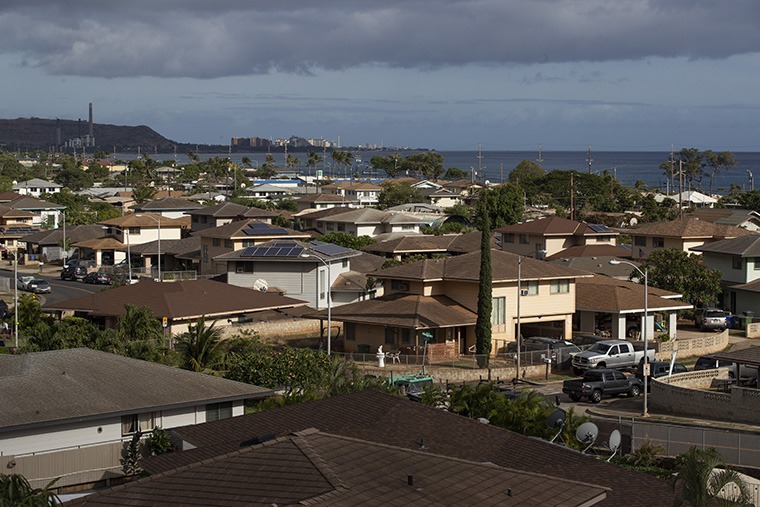 CINDY ELLEN RUSSELL / CRUSSELL@STARADVERTISER.COM
CINDY ELLEN RUSSELL / CRUSSELL@STARADVERTISER.COM Princess Kahanu Estates was developed to provide housing for the working poor, but many applicants didn’t qualify for the mortgages needed to purchase the homes.
Motivated to get Hawaiians onto the land, Kauhane helped craft a legal workaround that involved recruiting a waitlister’s family member who could finance the deal. The lease would be awarded to the applicant, who served as a pass-through and simultaneously transferred it to the family member bankrolling the purchase. Depending on the circumstances, the applicant still could live in the home. “That was the only way we could get these people or their families into a home,” Kauhane said. “They deserved that opportunity.”
There were more than 100 of these simultaneous transactions following lease awards in the past 25 years, according to the analysis. Even with the workarounds, though, the department still had to go more than 4,000 deep into the waitlist to get enough buyers for the 271 homes in Princess Kahanu Estates — an indication to some critics that the subdivision model was problematic from the start.
“THEY EXCLUDE PEOPLE LIKE MYSELF”
Over the years, Native Hawaiians have increasingly turned to the homesteading program for relief as Hawaii grapples with a severe shortage of affordable housing and the nation’s second-worst homelessness crisis. The statewide residential waitlist has grown by over 50% since 1995.
While DHHL does not track income in a systematic way, there are indications that many applicants are struggling financially. A federal study found that about 20% of households on the waitlist received public cash assistance — nearly three times the rate of Native Hawaiians and more than six times that of the general population. According to a separate 2014 survey conducted by DHHL, only about a quarter of waitlisters said they could afford the 10% down payment on a mortgage for a $150,000 home. Many turnkey properties now cost at least double that. In Kapolei on Oahu’s west side, where Kanehili was developed and where much of the island’s residential growth is happening, prices in new homestead neighborhoods are approaching $400,000.
“When you do all turnkey development, and the average price for a house is somewhere around $300,000 to $400,000, what happens is you start skimming the cream of the waitlist, only those who can qualify for those homes,” Aila, the DHHL director, acknowledged. “So you miss a lot of people.”
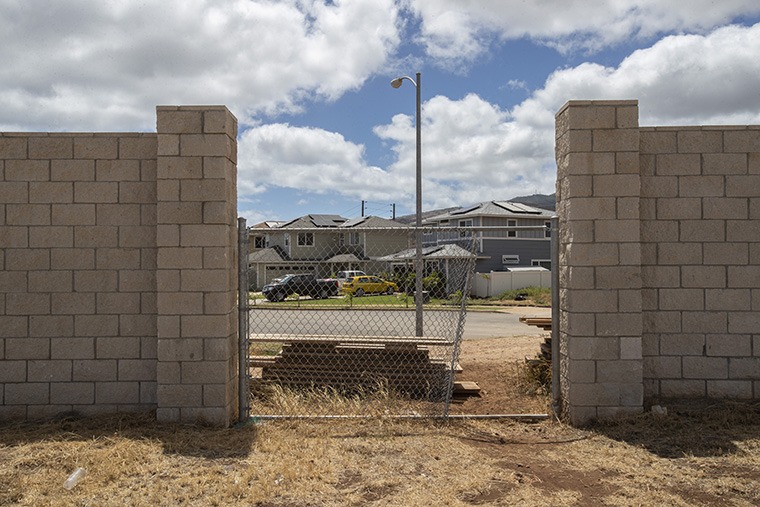 CINDY ELLEN RUSSELL / CRUSSELL@STARADVERTISER.COM
CINDY ELLEN RUSSELL / CRUSSELL@STARADVERTISER.COM Construction at the Kanehili homestead subdivision.
Robin Danner, a beneficiary leader from Kauai, said DHHL needs to rethink its financial requirements and give beneficiaries more flexibility to build their own housing. “Their duty is not to check my credit,” she said. “Their duty is to issue me my land.”
Aila acknowledged that the law does not require a beneficiary to qualify for a mortgage to get a homestead. But any structure built on trust land must meet county building and zoning codes, according to the state administrative rules the department uses, and that prohibits substandard construction. “We can’t let you live in a tent because that’s substandard living,” Aila said.
Critics, however, say DHHL, with its focus on subdivisions, has strayed too far from the intent of the 1921 homesteading law. “The program is really turned on its head,” said attorney Tom Grande, who represents 2,700 plaintiffs in a class-action lawsuit against DHHL that received the favorable Supreme Court ruling this year. “It’s serving Native Hawaiians who are middle class or upper middle class. It does nothing for Hawaiians who are working poor or homeless.”
Native Hawaiians are overrepresented in the homeless population. In a survey earlier this year of roughly 1,200 unsheltered homeless on Oahu, 1 in 5 was eligible for the homesteading program and 7% were on the waitlist.
Louisa Keawe, 60, applied for the homesteading program in 2010. Today, she lives in a tent at Waimanalo Beach Park on Oahu’s windward side. The former janitor says she has been homeless off and on for about seven years and hasn’t worked for about a decade because of a disability. She survives on about $800 in monthly Social Security benefits and food stamps, and she recently purchased a new tent with her federal stimulus check.
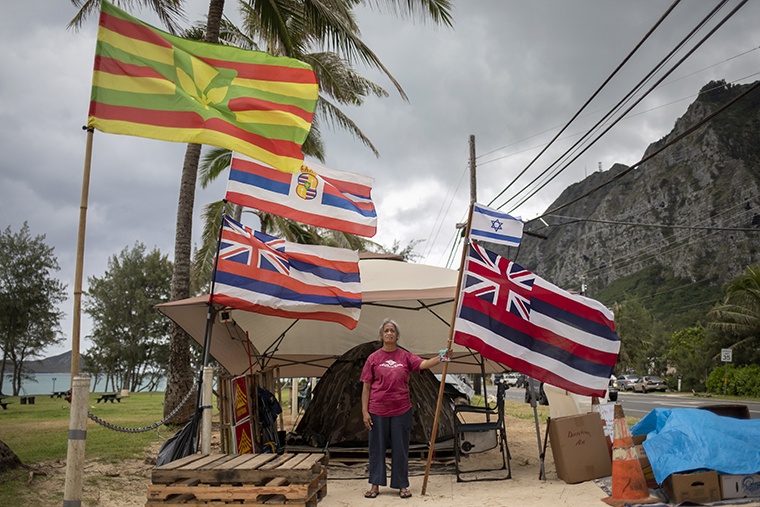 CINDY ELLEN RUSSELL / CRUSSELL@STARADVERTISER.COM
CINDY ELLEN RUSSELL / CRUSSELL@STARADVERTISER.COM Louisa Keawe, who has been on the homestead waitlist since 2010, lives in a tent at Waimanalo Beach Park.
Keawe said she has received several offering notices but didn’t pursue them, believing she was unable to qualify for a mortgage. The system, she lamented, favors those with wealth.
“People doing well on the high level, the first level, they can pursue a place on Hawaiian Homes. The second level? Average. They will pursue. But for my case, I cannot pursue nothing,” Keawe said. “They exclude people like myself.”
Age can also be a limiting factor. The Star-Advertiser and ProPublica found that more than half of all waitlisters are over 60, an age when taking on a new mortgage could be a stretch. The news organizations interviewed more than a dozen people who applied decades ago and are now approaching retirement age.
Oahu resident Gregory Ah Yat has been a renter all his adult life. He applied for the homesteading program 33 years ago but, like Keawe, passed on several lease offerings, either because he couldn’t afford them or he didn’t like the location. A longtime tour bus driver, he lost his job when the coronavirus pandemic shut down Hawaii’s tourism industry in March.
Now 68, Ah Yat has little hope of getting a homestead. “I’m going to die before that happens,” he said. “I’ll never be able to make the payments, not even in 30 years.”
“HANDOUT” OR HAND UP?
DHHL says it offers a variety of programs aimed at helping low-income beneficiaries become homesteaders. The services range from homebuyer education classes and financial literacy training to more direct financial aid.
Much of the funding comes from the U.S. Department of Housing and Urban Development, which has provided more than $150 million to the state agency over the past two decades. But that help has reached just a fraction of waitlisters.
Since 2002, more than 2,000 individuals and families have received homebuyer training and other assistance, according to Ryan Okahara, director of HUD’s Honolulu field office. In addition, about 600 waitlisters got financial aid to purchase — or build — homes on trust land.
Those making 80% or less of an area’s median income are eligible to tap the federal funds to obtain a zero-interest loan or down-payment assistance. On Oahu, that income limit translates to $67,500 for an individual and $96,400 for a family of four.
Shannon Chow applied for financial help several years ago. As an airline employee supporting a family of four, she qualified for a zero-interest loan from DHHL. The agency approved $267,000, which the 49-year-old Chow used to build a home on a vacant lot in Waimanalo, a historically Native Hawaiian community.
But, in a sign of how slow the homesteading process works, she didn’t get her lease based on her position on the waitlist, which was more than 4,500 from the top. She inherited it in 2018 when her mother, Cecilia Chow, died at age 70 that year. Cecilia had waited more than 30 years before getting her lease.
With the loan from DHHL, as well as assistance from Honolulu Habitat for Humanity, Shannon Chow constructed a 1,200-square-foot, four-bedroom, two-bathroom house on the site.
At the July ceremony in which she received the keys to her new residence, Habitat for Humanity placed an empty chair with a lei draped over it as a tribute to her late mother. Chow dabbed back tears as she glanced at the empty chair next to her, wishing her mother was there. “We’re always thinking of her,” Chow said after the ceremony. “It’s because of her we got this house.”
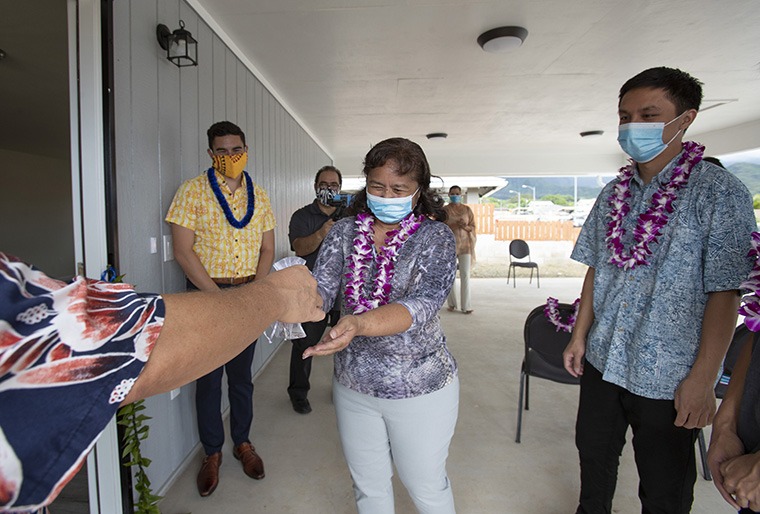 CINDY ELLEN RUSSELL / CRUSSELL@STARADVERTISER.COM
CINDY ELLEN RUSSELL / CRUSSELL@STARADVERTISER.COM Shannon Chow used the zero-interest loan she received from the Department of Hawaiian Home Lands to build a home on a vacant lot in Waimanalo, a historically Native Hawaiian community.
Blossom Feiteira, a Maui beneficiary who heads a waitlister group and used to teach financial literacy classes, said even homeless applicants can become homesteaders if they take advantage of the services and are willing to do what is necessary, such as improve their credit standing, to prepare for homeownership. “This is not supposed to be a handout,” she said. “It’s supposed to be a hand up.”
But other advocates say the programs are of little use to many struggling waitlisters. For example, those who receive the opportunity to get a lease with a turnkey home typically have to prequalify for a mortgage within 45 days. That isn’t enough time for most low-income waitlisters to get their finances in order, said Jeff Gilbreath, director of lending for the nonprofit Hawaii Community Lending, which serves beneficiaries. Vacant lots that the beneficiary builds on — like Chow did — can be an alternative, but they come with their own challenges, including securing a construction loan and managing contractors, he said.
Gilbreath estimates that even with federal and state assistance, it can take up to a year and a half for low-income beneficiaries working with his nonprofit to address credit issues and build the savings necessary to buy a homestead. And the assistance programs are severely underfunded.
Gilbreath said low-income waitlisters can seek mortgage assistance from a federal program, known as the Section 502 Direct Loan program, but applicants are competing against other people every year. In some cases, the program’s annual congressional allocation runs out before the end of the year, causing delays in aid. Beneficiaries who attempt to navigate the convoluted system can get discouraged and give up, Gilbreath said.
Success stories, he added, are “more the exception than the rule.”
FUNDING SHORTFALLS, SLOWED CONSTRUCTION
Aila acknowledged that his agency is not delivering homesteads in a prompt and efficient manner. The fundamental reason, he said, is inadequate funding. “Everybody agrees that is the problem. The Legislature agrees, the federal government agrees, we agree, the beneficiaries agree.”
The pace of construction started to slow substantially in the late 2000s as the agency battled allegations of mismanagement and dealt with funding shortfalls. To maintain operations, officials diverted money from construction to administrative costs. That resulted in fewer new lots produced and awards offered. In three of the past five years, residential awards fell into the single digits, according to the news organizations’ analysis. In 2018, only six such leases were awarded.
While the Hawaii Supreme Court ruled in 2012 that the state is constitutionally required to provide sufficient funding for the agency, the governor approved only about a fifth of the annual amounts DHHL has requested since then, department data shows.
Gov. David Ige did not respond to interview requests for this story, but he provided a written statement. While he did not directly address DHHL funding, he said budget requests submitted to his office from state agencies are based on what they believe to be sufficient funding. Still, they often “are three to four times or more than the resources available to us. As governor, I must prioritize and balance budget requests with available resources.”
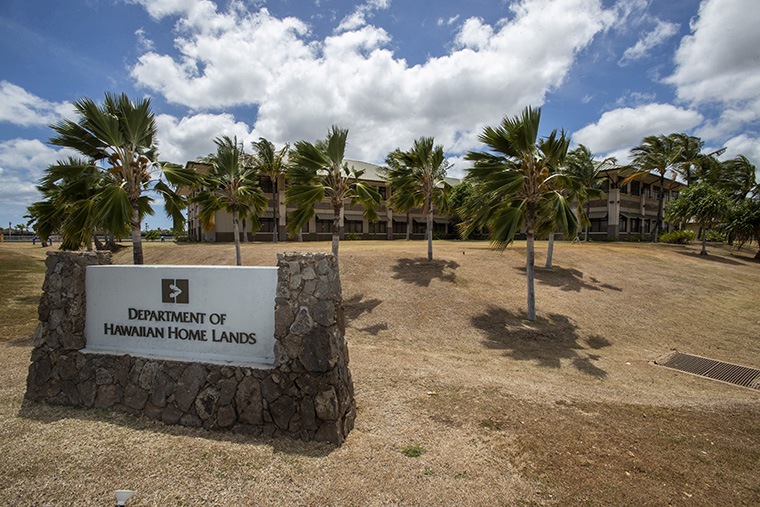 CINDY ELLEN RUSSELL / CRUSSELL@STARADVERTISER.COM
CINDY ELLEN RUSSELL / CRUSSELL@STARADVERTISER.COM The pace of homestead construction started to slow substantially in the late 2000s as DHHL dealt with allegations of mismanagement and funding shortfalls.
State Rep. Sylvia Luke, who heads the House Finance Committee, noted that the Legislature over the past eight years appropriated close to what the governor sought for the homesteading agency. Even though the amounts were less than what the department requested, they still were substantially more than what it had received historically.
“It’s so convenient just to blame it on funding,” she said.
Construction has picked up in recent years, and DHHL expects to offer hundreds of residential leases in subdivisions across three islands over the next few years. In December, the agency plans to hold a virtual meeting for 37 new turnkey homes in Kapolei. Prices range between $246,000 and $384,000.
But no subsidized assistance is available to help low-income waitlisters purchase the homes; instead, the agency is focusing on providing assistance for home construction on vacant lots, an option typically more affordable to those with fewer resources. Beneficiaries selected for the Kapolei houses would have to get financing through a conventional lender.
SCRAPPING THE MODEL
Some beneficiaries, advocates and political leaders say DHHL needs to scrap the subdivision model and craft a new one better in tune with the needs of waitlisters.
“The situation with DHHL I don’t think is a consequence of incompetence or skullduggery or indifference or even mediocrity,” said former Gov. Neil Abercrombie, who served from 2010 to 2014. “There’s elements of that in everything, no question. But principally it is that the model simply doesn’t serve the purpose. It was difficult right from the beginning, and it’s become impossible now.”
The Star-Advertiser and ProPublica analysis found it would take DHHL nearly two centuries to meet existing demand if it continues to develop at the current rate. “Good grief,” said U.S. Sen. Mazie Hirono, a Democrat from Hawaii, in response to the findings. “That’s why they can’t keep using that model.” She believes state legislators should hold hearings to probe the homesteading program.
On Oahu, where residential demand is greatest, the focus should be more on condominiums and other housing more affordable to waitlisters, critics say.
“Otherwise, the 100 years of failure will continue,” said Iwalani Laybon-McBrayer, a Kapolei homesteader and chair of the beneficiary-owned Homestead Housing Authority, a nonprofit that advocates for construction projects on trust land.
But not all beneficiaries agree. Homesteaders like Miyazaki are happy with the program. This year marks the 10th anniversary of her lease award for a two-bedroom house in Kapolei. “I love it, considering my mortgage is less than most people’s rent,” said Miyazaki, whose payments are $1,200 a month. “It feels really good to own a house.”
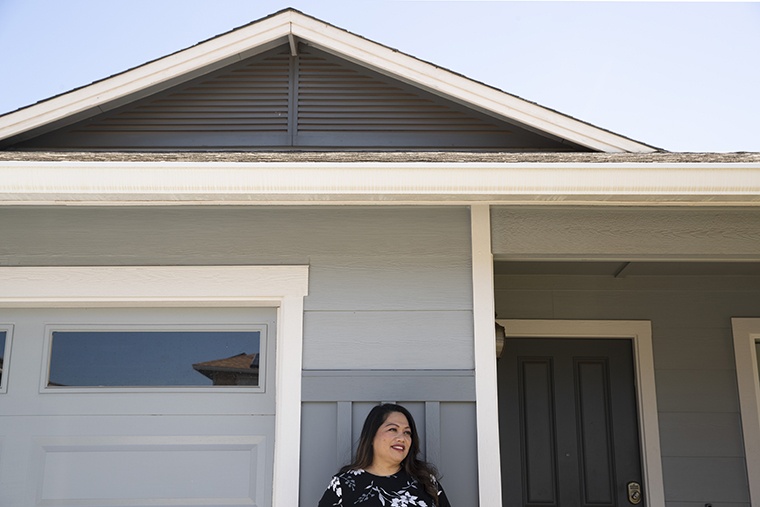 CINDY ELLEN RUSSELL / CRUSSELL@STARADVERTISER.COM
CINDY ELLEN RUSSELL / CRUSSELL@STARADVERTISER.COM Miyazaki, who owns a two-bedroom home, is happy with the homestead program.
Aila says DHHL is dedicated to its current housing model, particularly given the surveys conducted by the department showing most waitlisters still want single-family homes on standard lots, which are around 5,000 square feet.
When DHHL developed duplexes in the early 2000s near Papakolea, a homestead community just minutes from downtown Oahu, it had to go deep into the waitlist to find 86 buyers, including some who had applied less than two years earlier. The units sold for an average price, adjusted for inflation, of about $291,000.
That said, DHHL officials say they are responding to the calls for more affordable options for waitlisters. Since 2014, in reaction to beneficiary demands, the agency has revised its rules to allow for a wider array of housing choices, including tiny homes and multifamily dwellings.
Over the next five years, the department expects to develop a minimum of 1,300 lots — double the average rate over the past 25 years — for a variety of uses, including farming. About half will be for single-family homes, with most of the offerings in new subdivisions. The department also recently announced the selection of a developer for its first high-rise project, a 23-story building with 270 rental units in urban Honolulu. The units aren’t expected to come on line until mid-2024.
Older waitlisters say the changes, while welcomed, come too late for them. And critics say the moves are not nearly enough for low-income Hawaiians because the agency still relies too much on single-family turnkey housing — a model that’s at odds with the intent of the Hawaiian Homes Commission Act.
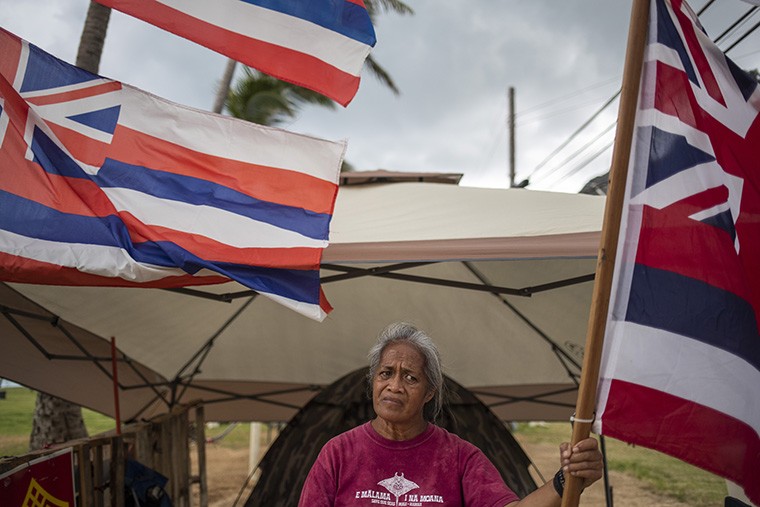 CINDY ELLEN RUSSELL / CRUSSELL@STARADVERTISER.COM
CINDY ELLEN RUSSELL / CRUSSELL@STARADVERTISER.COM Keawe said the homestead system favors those with wealth. “I cannot pursue nothing,” Keawe said. “They exclude people like myself.”
Carl Varady has seen the harm. As an attorney, he has worked with Grande representing 2,700 plaintiffs in the class-action lawsuit against DHHL. After 21 years and a string of legal victories, the beneficiaries are still waiting for compensation. About 400 have died since the suit was filed in 1999.
“Without people really looking at the purpose of this statute and living up to the fiduciary obligation,” Varady said, “there will be another generation of Hawaiians marginalized, living on the beach, and waiting for something they should have gotten decades ago.”
Rob Perez is an investigative reporter at the Honolulu Star-Advertiser. He has worked at newspapers in Florida, California, Hawaii and Guam, where he’s from.
Agnel Philip Opens in a new tab is a data reporter for ProPublica’s Local Reporting Network.



